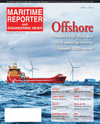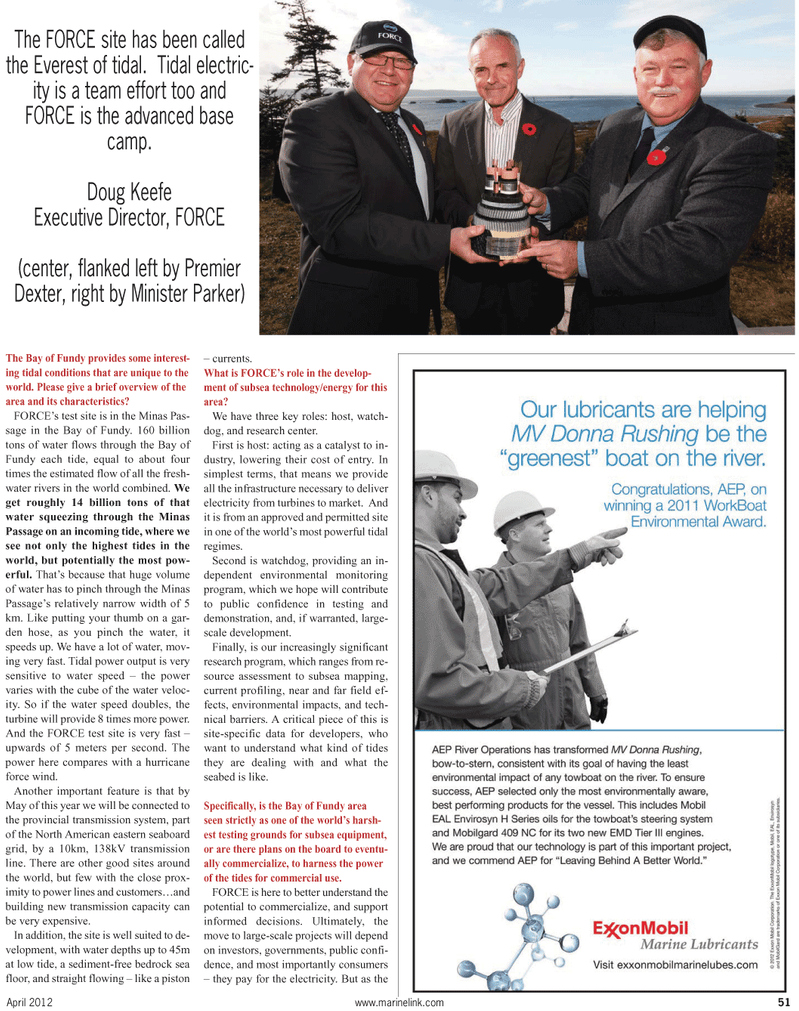
Page 55: of Maritime Reporter Magazine (April 2012)
Offshore Deepwater Annual
Read this page in Pdf, Flash or Html5 edition of April 2012 Maritime Reporter Magazine
The Bay of Fundy provides some interest- ing tidal conditions that are unique to the world. Please give a brief overview of the area and its characteristics? FORCEs test site is in the Minas Pas- sage in the Bay of Fundy. 160 billion tons of water flows through the Bay of Fundy each tide, equal to about fourtimes the estimated flow of all the fresh- water rivers in the world combined. Weget roughly 14 billion tons of that water squeezing through the Minas Passage on an incoming tide, where we see not only the highest tides in theworld, but potentially the most pow- erful. Thats because that huge volume of water has to pinch through the Minas Passages relatively narrow width of 5 km. Like putting your thumb on a gar- den hose, as you pinch the water, it speeds up. We have a lot of water, mov- ing very fast. Tidal power output is very sensitive to water speed ? the power varies with the cube of the water veloc- ity. So if the water speed doubles, the turbine will provide 8 times more power. And the FORCE test site is very fast ? upwards of 5 meters per second. The power here compares with a hurricane force wind.Another important feature is that byMay of this year we will be connected tothe provincial transmission system, part of the North American eastern seaboard grid, by a 10km, 138kV transmissionline. There are other good sites around the world, but few with the close prox- imity to power lines and customers?and building new transmission capacity can be very expensive. In addition, the site is well suited to de-velopment, with water depths up to 45m at low tide, a sediment-free bedrock sea floor, and straight flowing ? like a piston ? currents.What is FORCEs role in the develop- ment of subsea technology/energy for this area? We have three key roles: host, watch- dog, and research center. First is host: acting as a catalyst to in-dustry, lowering their cost of entry. In simplest terms, that means we provide all the infrastructure necessary to deliver electricity from turbines to market. And it is from an approved and permitted site in one of the worlds most powerful tidal regimes. Second is watchdog, providing an in- dependent environmental monitoring program, which we hope will contribute to public confidence in testing and demonstration, and, if warranted, large- scale development. Finally, is our increasingly significant research program, which ranges from re-source assessment to subsea mapping,current profiling, near and far field ef- fects, environmental impacts, and tech- nical barriers. A critical piece of this is site-specific data for developers, who want to understand what kind of tides they are dealing with and what the seabed is like. Specifically, is the Bay of Fundy area seen strictly as one of the worlds harsh- est testing grounds for subsea equipment, or are there plans on the board to eventu- ally commercialize, to harness the power of the tides for commercial use. FORCE is here to better understand thepotential to commercialize, and supportinformed decisions. Ultimately, the move to large-scale projects will depend on investors, governments, public confi- dence, and most importantly consumers? they pay for the electricity. But as the April 2012www.marinelink.com 51The FORCE site has been calledthe Everest of tidal. Tidal electric- ity is a team effort too and FORCE is the advanced basecamp. Doug KeefeExecutive Director, FORCE (center, flanked left by Premier Dexter, right by Minister Parker)

 54
54

 56
56
